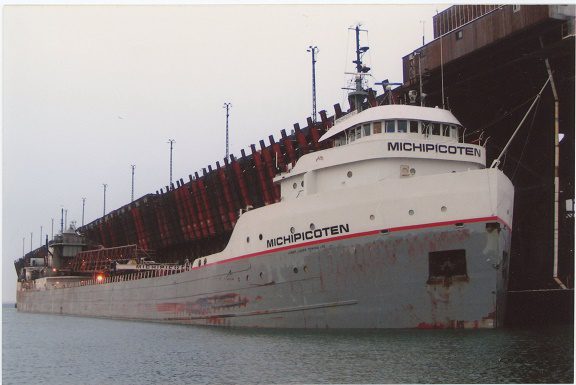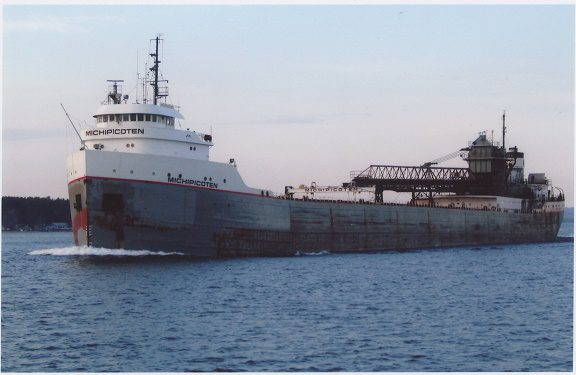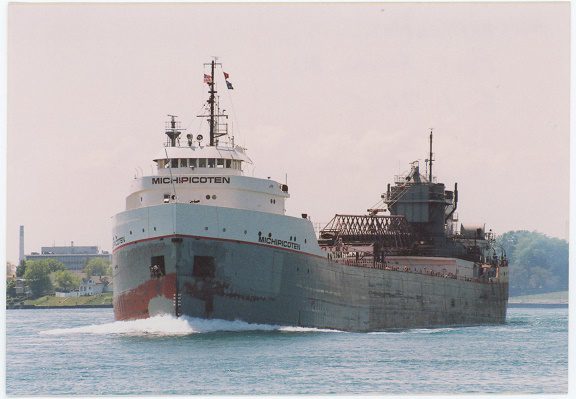By James Heinz
After World War II, the American economy boomed. The demand for steel and ships on the Great Lakes to carry the raw material for making it also boomed. As a result, Great Lakes shipping companies ordered a total of 13 new bulk carriers. In an unprecedented move, these ships were all built outside the Great Lakes.
Photo at top of page: The ELTON HOYT II as the MICHIPICOTEN fall of 2004 courtesy of Craig Olson
One of these ships was the ELTON HOYT II. She was launched in 1952 for the Interlake Company at the Bethlehem Steel shipyard at Sparrows Point, Maryland. HOYT II displaced 10,576 tons. She was 611 feet long and 70 feet wide. Her 7,000 hp steam turbine drove a five bladed propeller at 14 mph.
The St. Lawrence Seaway had not yet opened so the HOYT II and her two sister ships had to enter the Lakes through the method described in my previous article: https://wmhs.org/the-marine-angel-squeezed-down-the-chicago-river/ by bringing the ships up the Mississippi and Illinois Rivers and through downtown Chicago. This limited the length and width of the ships to a size that would fit through locks and bridges along the way.
The HOYT II’s move went smoothly until it reached the Van Buren Street Bridge in downtown Chicago where the ship was delayed when the steering gear on one of the accompanying tug boats failed.

MICHIPICOTEN at the LS&I ore dock in Marquette Mich, December 2004, courtesy of Craig Olson
In 1957, the ship was lengthened by 72 feet. In 1979 a 250 foot self-unloading boom was added. This reduced the ship’s total cargo capacity by 800 tons. However, it had previously taken 18-24 hours to unload the ship using a Hulett unloader. The boom could discharge 6,000 tons an hour and reduced unloading time to six hours. The quicker turnaround time more than made up for the reduced load.
As they say in the shipping business, “The boat doesn’t make any money while it is tied to the dock.”

MICHIPICOTEN upbound rounding Point Louise in the upper St Marys River, May 2005, courtesy of Craig Olson
In 1997, the HOYT II participated in an experiment involving moving 1,200 tons of sugar beets. Apparently, the experiment failed as it was not repeated. In December 1999, she suffered a 12 inch closed fracture in the #5 ballast tank. The pumps were able to handle it until she was patched.
In 2003, the HOYT II was sold Canadian to Lower Lakes Towing. She was re-christened the MICHIPICOTEN by breaking a bottle of champagne over her bow. In 2019 she rescued a man who rode a jet ski from Grand Portage, Minn., to Isle Royale but got lost and ran out of fuel on the return trip at night.
On June 8, 2024, it was déjà vu all over again for the HOYT II/MICHIPICOTEN. At 5:53 a.m. she was 35 miles southwest of Isle Royale the crew heard a loud bang followed by 600 gallons of water per hour pouring into the hull. The ship assumed a 15 degree list due to flooding into a starboard ballast tank and a centerline void space. Multiple ships responded to her distress call and 11 crew members were evacuated to other vessels including a National Park Service vessel from Isle Royal.

MICHIPICOTEN at Port Huron, Mich., June 2005, courtesy of Chuck Sterba
The MICHIPICOTEN limped into Thunder Bay and discharged her cargo. Divers found a hull fracture 13 feet long and a half inch wide running lengthwise in the hull. At first it was assumed that the ship hit a submerged object, but the water where she started leaking is 700 feet deep so that theory was discarded. The Coast Guard speculated that it was due to metal fatigue due to the age of the vessel.
On line sources indicate that MICHIPICOTEN was repaired at the Fraser Shipyard in Duluth. As of September 2024 she had not been approved for further operation by Transport Canada.
_________________
James Heinz is the Wisconsin Marine Historical Society’s acquisitions director. He became interested in maritime history as a kid watching Jacques Cousteau’s adventures on TV. He was a Great Lakes wreck diver until three episodes of the bends forced him to retire from diving. He was a University of Wisconsin – Milwaukee police officer for thirty years. He regularly flies either a Cessna 152 or 172.
Photo credit: Great Lakes Marine Collection of the Milwaukee Public Library and Wisconsin Marine Historical Society.

